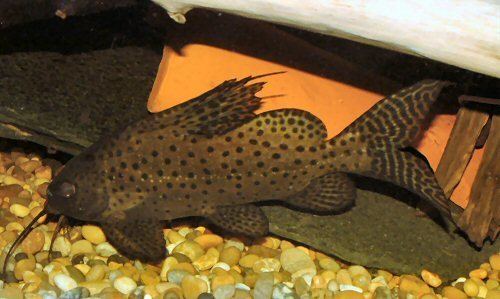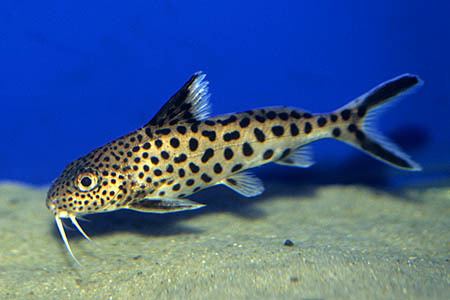Scientific name Synodontis Higher classification Mochokidae | ||
 | ||
Lower classifications Featherfin squeaker, Synodontis multipunctatus, Synodontis petricola, Synodontis nigriventris, Synodontis lucipinnis Similar Featherfin squeaker, Synodontis lucipinnis, Synodontis multipunctatus | ||
Synodontis eupterus eating an otocinclus catfish
Synodontis is the largest genus of mochokid catfishes. It is the biggest genus within the 10 genera and 190 different species in the Mochokidae family. Synodontis has over 131 different species within the genera. Synodontis are also known as squeakers, due to their ability to make stridulatory sounds through their pectoral fin spines when handled or disturbed. Synodontis make a sound that sounds like squeaking by rubbing their spines together. They do this when they have been frightened or when they become angry. "Synodontis" may also squeak when they are taken out of the water. These catfish are small- to medium-sized fish with many species exhibiting attractive spotted markings. Some species are also known for naturally swimming belly-up, earning the name upside-down catfish. Some of these species are Synodontis contractus and Synodontis nigriventris. While some of these species are known to swim upside down, another species, Synodontis multipunctatus, is a brood parasitic cuckoo catfish.
Contents
- Synodontis eupterus eating an otocinclus catfish
- Two catfish featherfin squeaker synodontis eupterus live fish 17 5cm 7
- Distribution
- Evolutionary history
- Fossil record
- Ecology
- Relationship to humans
- Species
- References

Two catfish featherfin squeaker synodontis eupterus live fish 17 5cm 7
Distribution
Synodontis is a freshwater catfish that is most commonly found throughout Africa, occurring mostly in Central and West Africa. Synodontis is the most widely distributed mochokidae genus, occurring throughout most of the freshwaters of sub-Saharan Africa and the Nile River system. They can live in freshwaters which can be creeks, ponds, streams, lakes, and rivers. Their distribution is similar to that of cichlid fishes, however, unlike cichlids the majority of their diversity occurs in rivers not lakes.
Evolutionary history

Synodontis catfish form a small endemic radiation in Lake Tanganyika, which includes the non-endemic species S. victoriae. This radiation is thought to have evolved relatively recently (~5.5. Million years ago), having diversified within full lacustrine conditions. This is also the case for other endemic Lake Tanganyika lineages such as mastacembelid eels and platythelphusid crabs for example. Lake Tanganyikan Synodontis have also been shown to be Müllerian mimics, and that at least one species (Synodontis multipunctatus) is a brood parasite.
Fossil record

The earliest fossils of Synodontis in East African are from the Early Miocene. Many Synodontis fossils are the spines because they are very sturdy and so they are preserved better. The fossils of spines that are found are used to determine the family or genera of the fish but it cannot determine the species. Synodontis species that have survived and are still living can be identified by the shape of their whisker like organs on their heads called barbels, which relate to touch. The can also be identified by the color of their skin, the skull bones, and the number and length of the teeth.
Ecology
Synodontis species are omnivorous generalists, feeding on a wide spectrum of different foods and are largely unspecialized. Insects, crustaceans, mollusks, annelids, seeds, and algae have been found in the stomachs of different species of Synodontis. They are bottom-feeders and may be detritivores, some species may also be able to adapt to filter feeding. This allows them to cope with seasonal and habitat changes and gives them a better ability to colonize different habitats. The different Synodontis species have somewhat different growth rates but most of them are fairly similar. In regards to the Synodontis genus for the different sexes, females are generally larger than the males. There is a great increase in growth the first year in both male and female and then the growth slows down as they become older. The form and structure of these fish are very different compared to other fish. The size and shape of the mouth are distinct because of its ventral mouth and these fish usually are triangular or cylindrical when looking at it from the side. Not much is known about the reproduction in these fish. It has been determined that July to October is when they spawn and that they swim in pairs during this spawning time. Species of Synodontis have been noted to reproduce with the flooding period of the rainy season.
Relationship to humans
Many Synodontis species are prized ornamental fish in the fishkeeping hobby. While some of the Synodontis species are prized because of their color or behavior, other species are wanted for food. Some of the bigger species in the genus are important food sources for the people in Africa.
Species
There are currently 131 recognized species in this genus: Synodontis accounts for about one-quarter of African catfish species. This genus has more members than any other African teleost genus other than Barbus and Haplochromis.
Newer species are listed with references.
